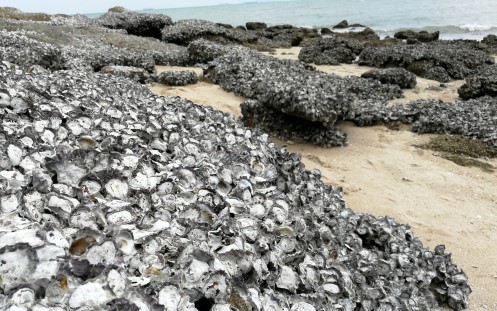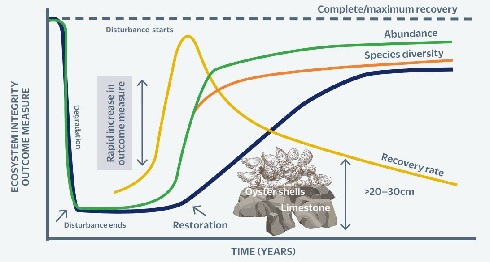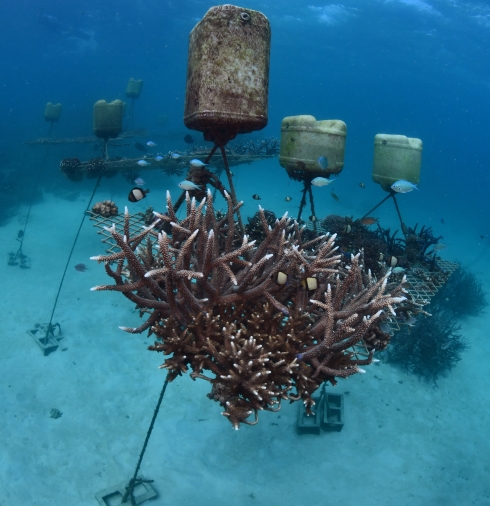Restoration Dramas

Amid a boom in restoration initiatives on land Samantha Andrews looks at the more complex challenge of restoring ecosystems under the waves
12th December 2022
In June 2021 the United Nations announced the Decade on Ecosystem Restoration: “a rallying call for the protection and revival of ecosystems all around the world, for the benefit of people and nature”. Restoration, the campaign says, is “a proven measure to fight the climate crisis and enhance food security, water supply and biodiversity”.
The ecosystems targeted for restoration are myriad and varied. Although efforts have historically focused on terrestrial systems and the number of tree-planting projects is now booming, the number of marine restoration projects targeting saltmarshes, oyster reefs and coral reefs is also now rising. As well as helping to restore biodiversity and sequester carbon, such restoration projects can also help improve coastal resilience, which is crucial as extreme weather events become more frequent and sea levels rise.
“I spent the first 15 years of my career showing how things like nutrient pollution or climate change are destroying our marine ecosystems,” says Dr Bayden Russell, associate director at the Swire Institute of Marine Science, University of Hong Kong. “For the last seven years I’ve been looking at ways to improve the state of the ocean and restore its ecosystems.”
In collaboration with The Nature Conservancy, Russell has been working on restoring Hong Kong’s lost oyster reefs. “Historically, oyster reefs were extensive throughout this region – we’ve got records going back over 1,000 years showing that they were fished,” says Russell. During the Tang Dynasty, demand for oysters intensified to meet growing demands for seafood and calcium oxide, derived from burning oyster shells, for construction and agriculture. “The problem is once you remove the physical reef structure, what used to be oyster reefs becomes mud and then you have nowhere for oyster larvae to settle,” Russell explains.
Rebuilding oyster reefs isn’t a particularly high-tech endeavour, but it is labour intensive. Discarded oyster shells from restaurants and aquaculture waste are used as the base material for restoration. After cleaning and drying the shells, they are left out in the sun for up to a year. Leaving the shells exposed to the sun’s UV rays kills off any remaining pathogens or invasive species, ensuring the reefs start with the best possible health.
Next, volunteers sort and place the cured shells into hessian bags ready to be deployed at the restoration site, Anniqa Law at The Nature Conservancy explains. “We engage different groups of volunteers – corporations, community organisations and schools – to do the bagging. At the same time they learn about oyster reefs, which is important,” she says, adding that knowledge about oyster habitats is generally low in Hong Kong. “They know how to eat oysters, but they don’t know that they are also an important marine habitat.”
At the restoration site, a base of limestone, which has similar chemical properties to oyster shells, is placed on the seafloor first. “Sediment is the big thing. If you’ve got sediment settling on top of where the oysters are supposed to come and settle… well, they aren’t going to,” Russell explains, noting that a high base also helps keep the oysters in oxygen-rich waters during the summer when seasonal hypoxia sets in at the bottom. The bagged oyster shells are then placed on this limestone base, creating the structural complexity and substrate essential for oyster larvae settlement.

Coral gardening
Not all restoration projects are recreating lost ecosystems. Many are working with existing, albeit degraded, ecosystems. “Although we call it restoration, I like to think of it more as rehabilitation because the patient is still there – they just need a helping hand,” says Dr David Suggett, team leader of the Future Reefs programme at the University of Technology, Sydney.
Suggett co-founded the Coral Nurture Program, an ambitious scheme to rehabilitate coral in parts of the Great Barrier Reef that have suffered from bleaching, where corals expel their symbiotic algae in response to increasing water temperatures or other stressors. Suspended in the water column, diamond-mesh aluminium frames covered in fragments of corals act as nurseries for the growing organisms. “The nurseries are typically teeming with life, including grazing fish that keep the coral clear of unwanted algal growth,” explains Suggett. Coral grows up to 10 times faster in the nurseries than on the reef.
The nurseries are in a high-flow area, so they have access to lots of nutrients, and predator numbers are much lower in the nurseries than on the reef. Once the corals reach a suitable size, they are harvested for planting on the main reef. “Sometimes we take clippings, sometimes we take full colonies, but typically it’s more effective to work with smaller fragments,” says Suggett.
There are several ways to plant corals. One approach is to bind rubble together to create a stabilising structure to which corals are attached with marine epoxy. However, the areas on which Suggett is working are prized tourist destinations. “It can look like underwater construction; it really just doesn’t look very pretty,” he says. In these areas coral fragments are instead attached with a Coralclip, a specially designed stainless steel spring clip, secured with an iron nail, that enables coral planters to rapidly attach the coral fragments to consolidated reef areas of bare rock. Once the fragments naturally ‘cement’ themselves to the substrate, divers can use metal detectors to find the nails and remove them.
 A model showing the recovery of oyster habitat with restoration. The blue line represents the overall recovery of oyster habitat, the red line cumulative species diversity and the green line cumulative abundance of oyster-reef-associated species. The yellow line indicates recovery rates after restoration.
A model showing the recovery of oyster habitat with restoration. The blue line represents the overall recovery of oyster habitat, the red line cumulative species diversity and the green line cumulative abundance of oyster-reef-associated species. The yellow line indicates recovery rates after restoration.Saving saltmarshes
Standing in downtown New York today, it’s hard to imagine that the city was once anything but a hive of human activity, but before European settlement the area was covered in saltmarshes, which gradually gave way to increasing levels of human activity. Fewer than 20% of New York City’s saltmarshes remain today and those that do are largely degraded. “Saltmarshes, and wetlands in general, have such a bad rep,” says Dr Dorothy Peteet, a senior research scientist at NASA/Goddard Institute for Space Studies and adjunct professor at Columbia University. “For years they’ve been a dumping ground because the land was cheap. People didn’t realise – and often still don’t – how important saltmarshes are.”
That perception is slowly changing. South of Brooklyn and Queens, on the western edge of Long Island, Jamaica Bay is New York’s largest natural area. Myriad species make Jamaica Bay’s saltmarshes their home for part or all of the year, but the system is vulnerable. With the threat of rising waters with the loss of the protective marshes, Jamaica Bay has had extensive restoration costing millions of US dollars.
“They’ve hardened the shoreline to prevent erosion. Where marshes are eroding away they spray a thin layer of sediment,” Peteet explains. Another technique for rebuilding sediment involves creating sediment mounds that erode with the movement of waves and tides, depositing sediment on upper intertidal areas. After spraying sediment the team must manually plant local marsh plants, which provide habitat, sequester carbon and trap sediment particles, stabilising the marshes and helping them accrete more sediment.
Of course, restored ecosystems such as saltmarshes aren’t isolated from the rest of the world – and the famous megalopolis nearby. Peteet says New York’s marshes suffer from high nitrogen and heavy metal loads, hampering the growth of plant roots that give the marshes their stability. Upriver, damming and the addition of concrete or large boulders to riverbanks will continue to starve the Jamaica Bay marshes of sedimentation. Even with restoration efforts, Peteet worries that with sea level rise the marshes won’t be able to accrete enough sediment to sustain themselves. “If we want the marshes to survive, we must address these pollution and sedimentation issues,” she says.
Russell says this ability to self-sustain is a critical feature of effective restoration: “If [the ecosystem] is not self-maintaining, you’re always going to be trying to prop it up and it’s never going to be properly functioning.” There is evidence that the Hong Kong oyster project is moving in the self-sustaining direction. “We put down some live oysters and we’ve had really good survival of those, and we’ve also had recruitment,” he says, adding that many other species are also colonising the reef.
In Australia Suggett reports the first ever spawning of replanted corals outside of the Caribbean. “It showed us we could take a small fragment [of coral], partially grow it in the nursery, replant it, and then it will reproduce and start taking care of itself. It means you’re not just planting one coral, but one coral that can potentially replant 10,000 corals on its own.”
For both oyster and coral restoration, one crucial knowledge gap in reaching self-sustaining systems relates to larval recruitment and survival. Reconstructing the oyster reefs with limestone and oyster shells can give off the correct chemical cues, but other factors are at play. Research coming out of the University of Adelaide, for example, has demonstrated that the sound of a healthy reef appears to be important in recruiting oyster larvae. Similar findings have been found for corals. Even if recruitment is successful, “knowing what makes larvae survive in spot x versus spot y, nobody really knows,” says Suggett. “If we can figure that out, it’d be a game-changer.”
For oyster reefs, Russell suggests the timeframe for restoring these ecosystems is 10 to 20 years (see ‘Oysters in recovery, p29). “We can demonstrate that we can increase diversity, the abundance of organisms and ecosystem functioning, but it’s going to take much longer than people think,” he says. “The initial recovery in the first two years is really quick. You get an influx of new organisms coming in, so your abundance and diversity rates increase, but then that rate crashes. You’ve still got that abundance there, but the recruitment of further species takes more time as that reef develops and becomes more functional.”
Russell cautions that restoration is unlikely ever to bring the system back to the same state as if it had never been damaged. “For every time point that system isn’t back to its original state, you’re accruing debt of all of the ecosystem functions and services that you’ve lost,” he explains. “You can never pay back that recovery debt, but you can reduce that debt quickly with restoration.”
 The Opal Reef coral nursery, one of several sites created by the Coral Nurture Program
The Opal Reef coral nursery, one of several sites created by the Coral Nurture ProgramEcosystem benefits
Most marine restoration projects are still relatively young. Recovery debts withstanding, they aim to provide benefits beyond the restored systems themselves. For example, modelling work by the NOAA Fisheries’ Office of Habitat Conservation suggests that, once matured, restored oyster reefs in Chesapeake Bay, US, will support an estimated 45% more biomass of commercially harvested fish, potentially creating a US$4.5m increase in dockside sale. Separate analyses by NOAA of the Chesapeake oyster restoration suggest that successfully restored reefs could also remove seven times more nitrogen than unrestored areas per day.
In Puerto Rico and Florida, US, researchers estimate that restoring coral reefs damaged or destroyed by hurricanes Irma and Maria in 2017 could create some US$273m in flood protection benefits a year. As for the benefits Queensland’s Great Barrier Reef tourist operators could reap from restoration efforts, Suggett says: “We’ve just been able to demonstrate that for every dollar invested in coral planting through us retains $10 of tourism value for the reef.”
There are, of course, examples of where scientifically backed restoration efforts have not gone quite as planned. For example, beach nourishment schemes at Jamaica Bay to provide American horseshoe crabs with suitable spawning grounds in the mid-2010s didn’t result in the hoped increased spawning densities. As Suggett notes, marine restoration is a relatively new science, so not all efforts will instantly succeed. “You can either theorise the hell out of it or you can get out there and learn by doing,” he says.
One of the most challenging benefits to calculate is the carbon storage potential of restored ecosystems. Governments are including such ‘blue carbon’ ecosystems in their climate mitigation plans, but such efforts predominately focus on plant-based ecosystems, such as seagrass meadows, saltmarshes and mangroves, which sequester more CO2 than they emit. Calcifying organisms such as oysters and corals, which are thought to be net emitters of carbon, are not currently considered blue carbon.
No two systems are the same
The problem in calculating their carbon storage potential is that no two saltmarshes, no two seagrass meadows and no two mangroves are alike. The carbon storage potential of saltmarshes, for example, is driven by a range of biotic and abiotic factors. Research on saltmarsh restoration in New England, US, also indicates carbon accumulation follows a similar pattern to that observed with species numbers on restored oyster reefs: initial rapid accumulation rates for the first 20 years, followed by a slowdown to a steady rate.
Even if we could accurately calculate the potential carbon storage of a specific saltmarsh, Peteet notes, climate change will likely alter their carbon storage potential. Increasing temperatures may reduce the cold that helps sediment preserve carbon-rich detritus and if sea level rise erodes the marshes, the detritus will be exposed.
One study exploring the storage potential of blue carbon concludes that blue carbon accounting is a risky business. “Coastal blue carbon ecosystems restoration should be in addition to, not as a substitute for, near-total emission reductions,” authors Dr Phillip Williamson (University of East Anglia) and Dr Jean-Pierre Gattuso (CNRS) conclude.
Nevertheless, the importance of marine ecosystems can’t be overestimated. “Every effort should be made to halt, and wherever possible reverse, the worldwide loss of coastal vegetation,” says Williamson. “Blue carbon habitats are more than carbon stores – they also provide storm protection, support biodiversity and fisheries, and improve water quality.”
Samantha Andrews is a writer, communicator, researcher and consultant specialising in marine science, marine technology, policy, environment, conservation and sustainability.


